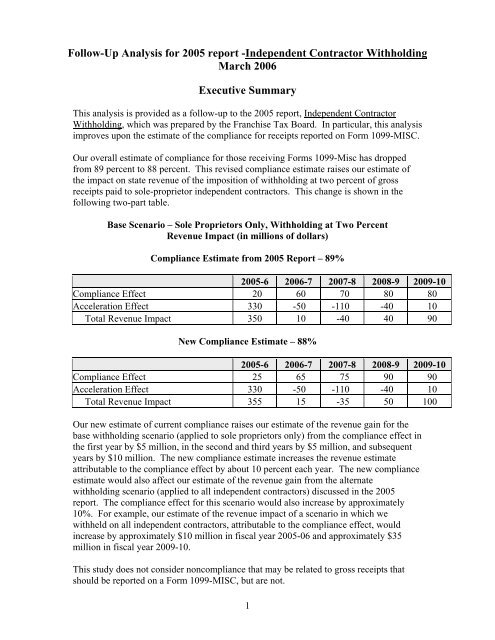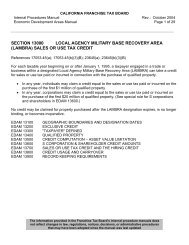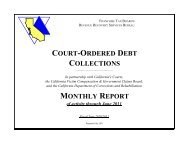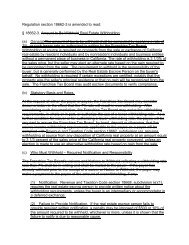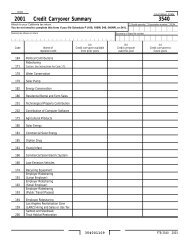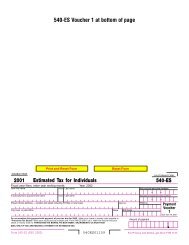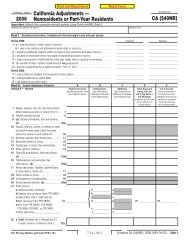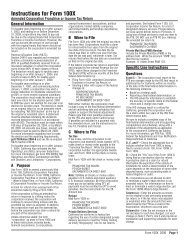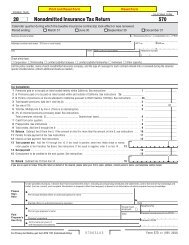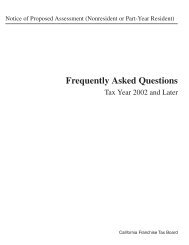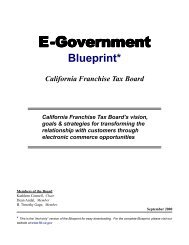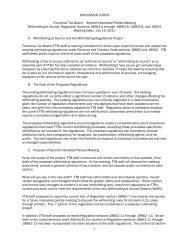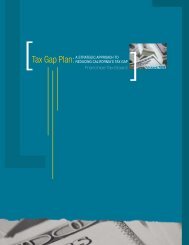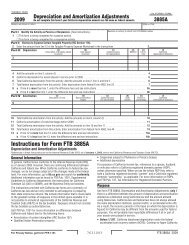Follow-Up Analysis for 2005 report - California Franchise Tax Board
Follow-Up Analysis for 2005 report - California Franchise Tax Board
Follow-Up Analysis for 2005 report - California Franchise Tax Board
Create successful ePaper yourself
Turn your PDF publications into a flip-book with our unique Google optimized e-Paper software.
<strong>Follow</strong>-<strong>Up</strong> <strong>Analysis</strong> <strong>for</strong> <strong>2005</strong> <strong>report</strong> -Independent Contractor Withholding<br />
March 2006<br />
Executive Summary<br />
This analysis is provided as a follow-up to the <strong>2005</strong> <strong>report</strong>, Independent Contractor<br />
Withholding, which was prepared by the <strong>Franchise</strong> <strong>Tax</strong> <strong>Board</strong>. In particular, this analysis<br />
improves upon the estimate of the compliance <strong>for</strong> receipts <strong>report</strong>ed on Form 1099-MISC.<br />
Our overall estimate of compliance <strong>for</strong> those receiving Forms 1099-Misc has dropped<br />
from 89 percent to 88 percent. This revised compliance estimate raises our estimate of<br />
the impact on state revenue of the imposition of withholding at two percent of gross<br />
receipts paid to sole-proprietor independent contractors. This change is shown in the<br />
following two-part table.<br />
Base Scenario – Sole Proprietors Only, Withholding at Two Percent<br />
Revenue Impact (in millions of dollars)<br />
Compliance Estimate from <strong>2005</strong> Report – 89%<br />
<strong>2005</strong>-6 2006-7 2007-8 2008-9 2009-10<br />
Compliance Effect 20 60 70 80 80<br />
Acceleration Effect 330 -50 -110 -40 10<br />
Total Revenue Impact 350 10 -40 40 90<br />
New Compliance Estimate – 88%<br />
<strong>2005</strong>-6 2006-7 2007-8 2008-9 2009-10<br />
Compliance Effect 25 65 75 90 90<br />
Acceleration Effect 330 -50 -110 -40 10<br />
Total Revenue Impact 355 15 -35 50 100<br />
Our new estimate of current compliance raises our estimate of the revenue gain <strong>for</strong> the<br />
base withholding scenario (applied to sole proprietors only) from the compliance effect in<br />
the first year by $5 million, in the second and third years by $5 million, and subsequent<br />
years by $10 million. The new compliance estimate increases the revenue estimate<br />
attributable to the compliance effect by about 10 percent each year. The new compliance<br />
estimate would also affect our estimate of the revenue gain from the alternate<br />
withholding scenario (applied to all independent contractors) discussed in the <strong>2005</strong><br />
<strong>report</strong>. The compliance effect <strong>for</strong> this scenario would also increase by approximately<br />
10%. For example, our estimate of the revenue impact of a scenario in which we<br />
withheld on all independent contractors, attributable to the compliance effect, would<br />
increase by approximately $10 million in fiscal year <strong>2005</strong>-06 and approximately $35<br />
million in fiscal year 2009-10.<br />
This study does not consider noncompliance that may be related to gross receipts that<br />
should be <strong>report</strong>ed on a Form 1099-MISC, but are not.<br />
1
<strong>Follow</strong>-<strong>Up</strong> <strong>Analysis</strong> <strong>for</strong> <strong>2005</strong> <strong>report</strong> -Independent Contractor Withholding<br />
Introduction<br />
In January of <strong>2005</strong>, the staff of the <strong>Franchise</strong> <strong>Tax</strong> <strong>Board</strong> (FTB), in consultation with the<br />
Employment Development Department and the Legislative Analyst’s Office, prepared a<br />
<strong>report</strong> regarding withholding on independent contractors. One of the issues critical to the<br />
fiscal impact and policy attractiveness of an independent contractor withholding program<br />
is the current level of compliance of independent contractors. In an attempt to address<br />
this issue, FTB staff estimated the current level of compliance <strong>for</strong> independent<br />
contractors who receive Forms 1099-MISC. This estimate is described in Appendix 1 of<br />
the <strong>report</strong> and is used in the estimates of the fiscal impact of various withholding schemes<br />
included in that <strong>report</strong>.<br />
A significant portion, almost one-third, of the gross receipts <strong>report</strong>ed on Form 1099-<br />
MISC were not thoroughly analyzed <strong>for</strong> the <strong>2005</strong> <strong>report</strong>, due to a of lack of data at that<br />
time. FTB staff have been asked to reassess compliance <strong>for</strong> that portion of gross receipts<br />
that were not thoroughly analyzed <strong>for</strong> the <strong>2005</strong> <strong>report</strong>. This follow-up analysis <strong>report</strong>s<br />
the results of that ef<strong>for</strong>t.<br />
Overview of Appendix 1 of the <strong>2005</strong> Independent Contractor Withholding Report<br />
In Appendix 1 of the <strong>2005</strong> <strong>report</strong>, we describe the methodology and results <strong>for</strong> our<br />
analysis of compliance on Form 1099-MISC. Our first step was to identify “the Forms<br />
1099-MISC in which the individual payee could be matched with a record from FTB’s<br />
Integrated Nonfiler Compliance reference file”. 1 For tax year 2001, this represented<br />
$47.6 billion of the $166.4 billion gross receipts that were <strong>report</strong>ed in boxes 6 or 7 of<br />
Form 1099-MISC. 2 We estimated a compliance rate of 91 percent <strong>for</strong> these taxpayers.<br />
Our next step was to per<strong>for</strong>m a second matching procedure using less strict matching<br />
criteria. Using these less strict matching criteria, we were able to match to an additional<br />
$24.5 billion in Form 1099-MISC gross receipts to individuals. When preparing our<br />
<strong>2005</strong> <strong>report</strong>, we did not have data available to separately calculate the compliance rate <strong>for</strong><br />
this group. There<strong>for</strong>e, we assumed this group would have the same compliance rate (91<br />
percent) as the group matched using the more strict criteria.<br />
In the <strong>2005</strong> <strong>report</strong>, we also estimated that there was an additional $2.2 billion in gross<br />
receipts <strong>report</strong>ed on Forms 1099-MISC in which the payee was an individual but which<br />
we were unable to match with a PIT taxpayer using either the more-strict or less-strict<br />
matching criteria. It was assumed that this $2.2 billion in gross receipts was never<br />
<strong>report</strong>ed on a tax return.<br />
1 This file contains in<strong>for</strong>mation on all taxpayers who have filed an individual tax return (i.e., Form 540)<br />
since 1999, or have been identified through filing en<strong>for</strong>cement ef<strong>for</strong>ts.<br />
2 Boxes 6 and 7 are the boxes on the Form 1099-MISC in which gross receipts <strong>for</strong> non-employee<br />
compensation and medical payments are <strong>report</strong>ed. These two types of payments were the focus of the<br />
estimate in the <strong>2005</strong> <strong>report</strong> as well as the withholding proposals discussed in that <strong>report</strong>.<br />
2
We, thus, had accounted <strong>for</strong> $74.3 billion in gross receipts as having been paid to an<br />
individual and <strong>report</strong>ed on a Form 1099-MISC 3 out of a total of $166.4 billion in gross<br />
receipts <strong>report</strong>ed on Forms 1099-MISC. Our overall estimate of compliance <strong>for</strong> this<br />
$74.3 billion was 89 percent.<br />
Methodology <strong>for</strong> Current Study<br />
For this study, we have focused on the group of Forms 1099-MISC that were matched<br />
using the less-strict criteria. Our approach was to draw a stratified-random sample of<br />
gross receipts <strong>report</strong>ed on Forms 1099-MISC and analyze that sample. Our sample size<br />
was about 1,500 unique payees, and was selected such that our sampling error was less<br />
than 3 percent at the 95 percent confidence level. The first step in our analysis was to<br />
determine if the payee of the Form 1099-MISC was in fact an individual. Since we had<br />
used less-strict matching criteria, it was possible <strong>for</strong> a Form 1099-MISC in which the<br />
payee was a corporation, LLC, or other type of business entity to be matched with an<br />
individual. We found that almost half of the gross receipts matched with individuals fell<br />
into this category. There<strong>for</strong>e, these gross receipts were deemed to not be a proper subject<br />
of this study. That left us with $13.4 billion in gross receipts from Forms 1099-MISC in<br />
which the payee was an individual.<br />
Of this $13.4 billion in gross receipts, $12.2 billion was attributable to individuals who<br />
filed 2001 PIT tax returns. Using the same approach we applied in our <strong>2005</strong> study, we<br />
checked the 2001 PIT tax returns <strong>for</strong> these taxpayers to determine if the gross receipts<br />
<strong>report</strong>ed on the Form(s) 1099-MISC were <strong>report</strong>ed on the taxpayer’s tax return. This<br />
analysis showed that $12.1 billion of the gross receipts were <strong>report</strong>ed on tax returns. The<br />
remaining $1.2 billion in gross receipts attributable to taxpayers who did not file tax<br />
returns was assumed to be noncompliant. The estimated compliance <strong>for</strong> these two groups<br />
was 90.5 percent, slightly lower than the 91 percent that we had assumed in the <strong>2005</strong><br />
<strong>report</strong>.<br />
Finally, there was, as with the prior study, a group of taxpayers who could not be<br />
matched with an individual or a business entity using either the strict or less-strict<br />
(automated) matching criteria. The gross receipts on these Forms 1099-MISC totaled<br />
$3.9 billion. We analyzed the largest (in terms of gross receipts) of these Forms 1099-<br />
MISC manually and determined that slightly more than one-half, or $2.1 billion, of the<br />
gross receipts could be attributed to individuals. This group was assumed to be<br />
noncompliant.<br />
Summary<br />
The estimate of compliance <strong>for</strong> receipts <strong>report</strong>ed on 2001 Forms 1099-MISC can be<br />
divided into three components. These components are shown in the following table.<br />
3 The remainder of the gross receipts <strong>report</strong>ed on Forms 1099-MISC was matched with entities other than<br />
individuals (corporations, partnerships, LLCs, etc.) It is much more difficult to track the compliance on<br />
receipts earned by these taxpayers, because it often involves tracing the passthrough of income through two<br />
or more entities. We limited the scope of this analysis (as well as the analysis in <strong>2005</strong> Independent<br />
Contractor Withholding <strong>report</strong>) to gross receipts <strong>report</strong>ed on Forms 1099-MISC to individuals.<br />
3
Summary of Results<br />
<strong>Tax</strong> Compliance <strong>for</strong> Gross Receipts Reported on 2001 Forms 1099-MISC<br />
Gross receipts <strong>report</strong>ed on Forms 1099-MISC<br />
matched to individuals using<br />
Total Form<br />
1099-MISC<br />
receipts (Billions<br />
of Dollars)<br />
4<br />
Compliance<br />
Amount<br />
(Billions of<br />
Dollars<br />
Compliance<br />
Rate<br />
more-strict matching criteria $47.6 $ 43.3 91.0%<br />
less-strict matching criteria $13.4 $12.1 90.5%<br />
neither the more-strict nor the less-strict matching<br />
criteria. $2.1 $0.0 0.0%<br />
Total $63.0 $55.4 87.9%<br />
First, there is the $47.6 billion attributable to the Forms 1099-MISC matched using the<br />
more-strict criteria. For this group we estimated compliance of $43.3 billion, <strong>for</strong> a<br />
compliance rate of 91 percent. Next, there is the $13.4 billion in gross receipts<br />
attributable to the Forms 1099-MISC matched using the less-strict criteria. We estimated<br />
compliance <strong>for</strong> this group at $12.1 billion, <strong>for</strong> a compliance rate of 90.5 percent. Finally,<br />
there is the $2.1 billion of gross receipts attributable to the Forms 1099-MISC which,<br />
though considered to be ones <strong>for</strong> which the payee was an individual, could not be<br />
matched with any individual on the FTB’s Integrated Nonfiler Compliance reference file.<br />
This group has a compliance rate of 0.0 percent. Overall, the estimated compliance rate<br />
<strong>for</strong> gross receipts <strong>report</strong>ed on boxes 6 and 7 of Forms 1099-MISC <strong>for</strong> 2001 is 88 percent.<br />
This is just below the compliance rate estimated in the <strong>2005</strong> <strong>report</strong> of 89 percent.<br />
Although it is a relatively small decline in the compliance rate, it does have an impact on<br />
our revenue estimates of withholding on independent contractors. This impact can be<br />
seen be comparing the following two-part table.<br />
Base Scenario – Sole Proprietors Only, Withholding at Two Percent<br />
Compliance Estimate from <strong>2005</strong> Report – 89%<br />
Revenue Impact (in millions of dollars)<br />
<strong>2005</strong>-6 2006-7 2007-8 2008-9 2009-10<br />
Compliance Effect 20 60 70 80 80<br />
Acceleration Effect 330 -50 -110 -40 10<br />
Total Revenue Impact 350 10 -40 40 90<br />
New Compliance Estimate – 88%<br />
<strong>2005</strong>-6 2006-7 2007-8 2008-9 2009-10<br />
Compliance Effect 25 65 75 90 90<br />
Acceleration Effect 330 -50 -110 -40 10<br />
Total Revenue Impact 355 15 -35 50 100
Taking into account our new estimate of current compliance raises our estimate of the<br />
revenue gain from the compliance effect in the first year by $5 million, in the second and<br />
third years by $5 million, and subsequent years by $10 million. The new compliance<br />
estimate increases the revenue estimate attributable to the compliance effect by about 10<br />
percent each year. The new compliance estimate would also affect our estimate of the<br />
revenue gain from the alternate withholding scenario (applied to all independent<br />
contractors) discussed in the <strong>2005</strong> <strong>report</strong>. The compliance effect <strong>for</strong> this scenario would<br />
also increase by approximately 10%. For example, our estimate of the revenue impact of<br />
this alternate scenario, attributable to the compliance effect, would increase by<br />
approximately $10 million in fiscal year <strong>2005</strong>-06 and approximately $35 million in fiscal<br />
year 2009-10.<br />
The limited scope of this study should be noted. The focus of this study was the<br />
compliance rate <strong>for</strong> receipts that are <strong>report</strong>ed on Forms 1099-MISC. There is likely to be<br />
additional noncompliance <strong>for</strong> income that should be <strong>report</strong>ed on Forms 1099-MISC, but<br />
is not. This study does not account <strong>for</strong> this phenomenon.<br />
5


